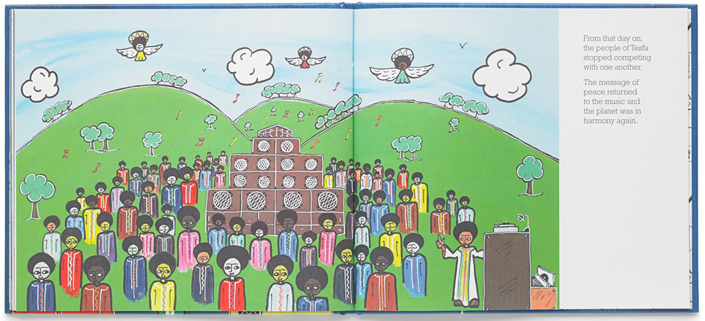‘The Sonar System’—Restoring Peace Through Sound System Culture

The project was well received and in 2014 taken on a national tour, which included new exhibitions in Bristol, Birmingham and London. Connected to this second phase of the Sound System Culture project, French sound system mainstay Ras Mykha was commissioned to create a children’s picture book revolving around sound systems. The Sonar System, released this year through One Love Books, uses that setting and takes on the idea behind the #WeNeedDiverseBooks campaign, which “advocates essential changes in the publishing industry to produce and promote literature that reflects and honors the lives of all young people.”
The Sonar System takes place in a universe called Betre, where the planets revolve around a giant speaker, rather than a sun. The people of Tesfa, one of the planets in this galaxy, build sound systems and listen to music that promotes positive messages while preventing negative ones. The sound systems grow louder and louder, overwhelming the benefits of the giant speaker and in the process, making peace disappear. The Malake, who in the book look identical to the people of Tesfa, only with angel wings, blow the speakers over, eradicating the competition and restoring peace.
Drawing from his extensive experience as a singer and MC, as well as his talents as a painter and songwriter, Mykha’s The Sonar System is vibrant and colorful, blending indigenous African styles of art with urban street art. He creates uniformity within the characters via identical hair and clothing, differing only in the colors of their clothing and skin.
Mykha has performed around Europe with the sound systems Lion Roots, Roots Meditation, Dub Livity, and Revelation HiFi. He released the Ras Mykha Meets Roots Ista Posse album Rootikal Showcase on Patate Records earlier this year and will be releasing the 10″ “Don’t Blame” on his own Cry in Soul Records later this month. He draws parallels between the culture of sound systems, projecting that against the larger backdrop of our world, but seen through the unadulterated eyes of children.
How did The Sonar System come about?
The book is a part of the Sound System Culture project run by Mandeep Samra. She came to me with the proposal for a children’s book about sound systems because I’m a painter and active in the sound system dub scene as a singer and MC. It was a good opportunity to combine those and create this book.
You’re a painter and a performer, but are you also a writer?
I’ve done writing for a long time, writing songs and poetry, but it was my first time for a book. Writing a book for a child is very similar to a song: short, simple, effective, like a lot of parables.
What kind of direction did you get for the book?
The direction was to speak about sound systems and something universal for everyone. In Europe, we have a very active and mixed sound system scene—all colors together, sharing time, skanking and dancing all night long. The book is about that: unity.
How did the story idea come about?
The idea started from a reasoning about “words, sound and power.” In the music, you have the words of the song, “the message”; you have the sound, “the music”; and the power, because in a sound system, you feel the music physically, as the sound is very loud, particularly the bassline. Those are the three elements of the sound system. In this time, there is a lot of competition. Who has the most power? The message and the melody are not so important, so the idea came from that reasoning. So it’s the actual world in competition, but it’s not a good competition; it’s more a question of power. The education isn’t working together, but against each other: neighbor against neighbor, nation against nation, color against color.
How was the book created?
I wrote the story first, and afterward made a storyboard. I started to imagine each scene, and it was very easy. Things came very fast. I painted all the pages on large-size, strong paper so they could be scanned.
In the book’s images, the clothing and hair are similar for all the characters; only the shades of skin are different. What was the thought process behind that?
My inspiration came from Ethiopian art and contemporary street art. Sound system culture comes from the working class and the immigrants. One couldn’t go into clubs because of no money, and the other reason was skin color. Now, in 2015, when you go to a sound system, you see diversity, all colors, all nations. People forget, we are the same, the only difference is color—same blood, same flesh, just a question of color. I used one kind of personage to show humanity as one. But in the same way, everyone is different. I could have used eye color or hair color, but it wouldn’t have been relevant enough. In the end, we can say we are all human; the color isn’t important.
So, keeping the characters ethnically neutral is intentional?
Yes, exactly, so everyone can identify with them. When I did this book, it was for everyone, particularly children. They don’t care about color. That’s more an adult thing. I am creating a book for every child—black, yellow, white, pink, red, green—and for their parents.










